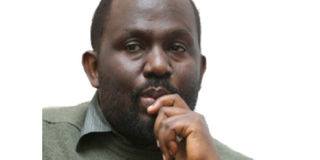Kenya just redrew the Uganda map – in a most unlikely way

About a week ago, Kenya’s Transport minister James Macharia said something that didn’t make newspaper or TV headlines – it should have.
He announced that “all” cargo destined for Uganda, Rwanda and South Sudan will be transported via standard gauge railway (SGR) for clearance at the Naivasha Inland Container Depot (ICD), starting June 1. The chiefs - President Paul Kagame of Rwanda, President Uhuru Kenyatta, our man President Yoweri Museveni, and South Sudan’s President Salva Kiir – he said, had “considered appropriate cross-border transportation modalities to reduce human traffic without impacting negatively on transportation of cargo across the borders, and the use of SGR is one of them.”
A while back, Kenya gave Uganda land at the ICD, and lately Rwanda too. This development was a big deal and deserved may be not a screaming line, but a two-page spread inside. In the post-Coronavirus period, it will become clear why. The distance between Kampala and Mombasa, Uganda’s main export and import route, by road is 1,146.9 kilometres, and 20 hours without traffic.
With traffic, roadblocks, weighbridges, road accidents, and border delays, it is between 50 to 72 hours for trucks. Effectively, the Mombasa port now has been brought 580 kilometres, and 10 to 20 hours closer to Kampala, and the same distance closer to Kigali. Because Kampala is
1,147 kilometres from Mombasa, it has nearly cut that down by half! Everything remaining the same, the cost of ferrying goods from Mombasa to Kampala should be anything between 25 to 35 per cent cheaper, with an equal reduction in time.
But of itself that wouldn’t be game changing, except for two other things. Again, partly because of Covid-19, transport of goods from Kisumu port to Port Bell and onward over Lake Nalubaale (Victoria) has got a shot in the arm. The lake transport itself resumed at the start of the year, with wagons carrying diesel loaded on ships to Uganda. However, Kisumu port is an aspect of a bigger story of economic realignment in Kenya.
It is part of a micro economic bloc comprising 14 devolved counties around Lake Nalubaale and its neighourhood working together to improve their economic fortunes. It is called the Lake Region Economic Bloc (LREB), and one of its key planks is to realise a lucrative blue economy from the water resources in the region, with Nalubaale and Kisumu being central to that element.
The 14 counties are Homa Bay, Bomet, Bungoma, Busia, Kakamega, Kericho, Kisii, Kisumu, Migori, Nyamira, Nandi, Siaya, Trans-Zoia, and Vihiga. There are plans to rebuild the railway from Naivasha, onward to Kisumu. I list them because if you look at the Kenyan, then Ethiopian, maps the creation of LREB and the Naivasha inland depot, have
brought in a third part of the puzzle. The construction of the Mombasa-Nairobi-Addis Ababa road, has gone a long way. It’s projected, conservatively, that with that corridor up and running, trade between Kenya and Ethiopia could jump by as much as 500 per cent. Already, though Ethiopia is not part of the East African Community, the two countries have a one-stop border post
(OSBP), much like Uganda and Kenya have at Malaba and Busia. With the combination of Naivasha inland depot and LREB, Ethiopia has all but a trading border with Uganda. The distance between Moyale and Mombasa is 1,208 kilometres, but to Naivasha it is 794 kilometres. There are three more pieces of the puzzle, but we have space for only one.
Tanzania President John Magufuli is a strange man, as we all know, but perhaps since Julius Nyerere, in his bulldozer way, no president there has exerted a greater effort to make Dodoma the capital of Tanzania that it is in law. Now, the distance between Mutukula, Uganda’s main formal trade border with Tanzania, and Dar es Salaam, the second key port for us, is a whopping 1,448.6 kilometres and anything between 24 and 48 hours on good days.
If Dodoma was to become a true capital, and some key commercial functions moved there over time from Dar, up to 39 per cent of the business functions between Uganda and Tanzania would move 444 kilometres closer. But perhaps more critical, Mwanza, which is 1,128 kilometres from Dar es Salaam, and is a key loop in the growth of a new Lake Nalubaale economic sphere, would also be that closer. For Uganda then, the cost and speed of doing business, could drop significantly and the savings will turn over money in the bank for entrepreneurs, and wealth in the economy. And the depth of our “landlockedness” will, and is shrinking, considerably in practical terms. The physical map will remain the same. But we will need to draw a totally new economic one.
Mr Onyango-Obbo is a journalist, writer, and curator of the ‘Wall of Great Africans’ and publisher of explainer site Roguechiefs.
@cobbo3




